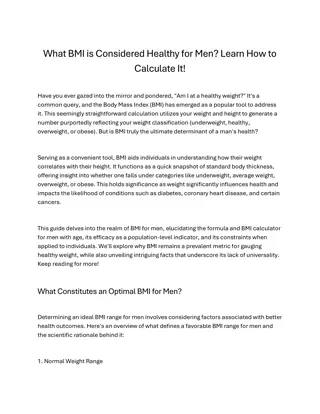Unveiling the Controversy Surrounding BMI and Its Historical Evolution
The body mass index (BMI) is a widely used measurement to determine healthy body weight based on height and weight. However, it does not directly measure body fat percentage, sparking controversy. Discover the origins of BMI from Adolphe Quetelet to Ancel Keys, its categories, and how it evolved to influence population health trends despite initial warnings against individual use. Explore recent variations for children and non-North Americans and the impact on shifting millions into different weight categories.
Download Presentation

Please find below an Image/Link to download the presentation.
The content on the website is provided AS IS for your information and personal use only. It may not be sold, licensed, or shared on other websites without obtaining consent from the author.If you encounter any issues during the download, it is possible that the publisher has removed the file from their server.
You are allowed to download the files provided on this website for personal or commercial use, subject to the condition that they are used lawfully. All files are the property of their respective owners.
The content on the website is provided AS IS for your information and personal use only. It may not be sold, licensed, or shared on other websites without obtaining consent from the author.
E N D
Presentation Transcript
Introduction The body mass index (BMI) is a statistical measurement using a person s height and weight to determine their healthy body weight.
Introduction BMI is controversial, because it does not actually measure a person s percentage body fat. It just displays what a healthy weight range would be for a person s height.
Introduction It is so easy to determine, which makes it so widespread in use. Mathematically it is figured out by the equation on the right. Most people, however, just use a BMI chart which are widely published.
The History Behind It BMI was formulated around 1840 by Adolphe Quetelet. He was a Belgian Renaissance Man . He took a person s mass in kilograms and divided it by their height in meters, squared. This gave BMI, which was originally called the Quatelet Index.
The History Behind It The term BMI came about in the 1970s in a paper by Ancel Keys. He was a scientist who looked at the influence of diet on health. He coined the categories for BMI: underweight, healthy, overweight and obese.
The History Behind It Keys said BMI could only be used when dealing with population studies and not individual studies, as he felt this was inappropriate. Unfortunately no one heeded his advice and BMI started to become a widespread measurement used to determine a person s fatness or thinness .
The History Behind It BMI s original purpose was to determine if inactive people were at a healthy weight since their diet would be the only thing to regulate their size. Knowledgeable doctors and scientists use it for population trends only.
Improving BMI There are lots of things BMI does not account for, however, recently there have been variations implemented for children and for non- North Americans. This last variation was adopted by the World Health Organization (WHO) and consequently moved 30 million previously healthy Americans into the overweight category.
BMI for The Under 20s This compares the BMI total with the general averages for children and not adults. Calculate your BMI on the BMI Index and then plot it and your age on the chart. Anywhere between the 5thand 85thpercentile is considered healthy .
International BMI Categories Unfortunately our world is one of have and have not and consequently the WHO has added the categories of Starvation to anyone who has a BMI under 15 and morbidly obese to anyone who has a BMI over 40. BMI range kg/m2 Category Starvation less than 14.9 Underweight from 15 to 18.4 Normal from 18.5 to 22.9 Overweight from 23 to 27.5 Obese from 27.6 to 40 Morbidly Obese greater than 40
Conclusion While BMI is fast and easy to calculate, it should not be the be all end all of determining whether or not someone is at a healthy weight. However, if someone has a low BMI or a really high BMI, that should signal the potential for health problems and that person should see their doctor to discuss this.
Homework What does BMI stand for? What does it calculate? What does BMI take into consideration in its calculation? What are three limitations of the BMI calculation? Another way of saying this is what are three things BMI does not take into consideration. Calculate your BMI using the BMI index and compare the category you are in with the percentile you are in on the BMI for the U20s. Are you in the same category on both charts? What country/countries do you believe would have the most people who fall into the morbidly obese category? Why? What country/countries do you believe would have the most people who fall into the starvation category? Why? 1) 2) 3) 4) 5) 6)
Healthy or not? Arnold DJ Qualls
Healthy or not? Keira Knightley Oprah Winfrey























